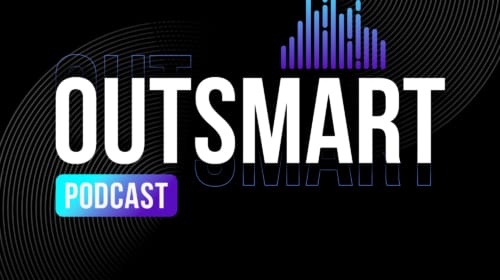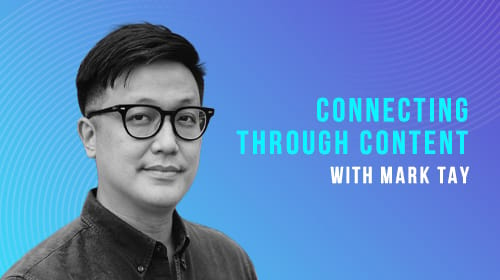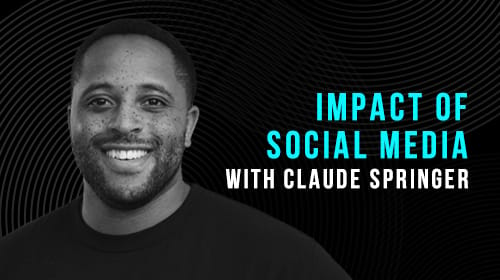Season 1, Episode 1: 2022 Marketing Predictions
In the premiere episode of Outsmart, meet your hosts Nicole Allen and Rex Petrill as they discuss predictions for the marketing industry in 2022. Nicole leads TEAM LEWIS’ innovation & growth execution as our SVP, Growth Strategy and Rex is our VP of Paid Media, ensuring our client’s success through paid media channels.
In this episode our hosts unpack:
– Meeting your audience where they are
– Community building through empathy and authenticity
– The creative imperative for flexibility and contingency planning
Resources Mentioned
– 2022 Marketing Predictions Blog
•·················•·················•
Nicole: Welcome to our first official episode of Outsmart, a podcast where myself and Rex Petrill will be joined by marketers who are smarter than we are to dissect just exactly how brands can outsmart the competition with creative, content, omnichannel campaigns. I think, given that this is our first time getting to know our listeners, it would be a good idea to give some introductions. My name is Nicole Allen. I’m a VP of Digital here at TEAM LEWIS. My background is in more integrated marketing and campaigns. My bread and butter. I live in the B2B tech space, used to work in the NBA and shifted gears quite dramatically off a Craigslist job posting (that dates me a bit.) And Rex, I’ll pass it over to you to introduce yourself.
Rex: Thanks Nicole, I’m Rex Petrill. I’m the head of Paid Media here in the United States, For TEAM LEWIS, and it’s a great pleasure to talk to my friend and colleague Nicole, and hopefully we can help you guys as marketers understand the landscapes, join in on timely events as they happen, like, what the heck is going to happen with CES and everything this week? And we can help you navigate these challenging and uncertain times. My background has been in digital and Paid Media for the last 10-12 years and I have led some really big engagements on both the B2B and consumer side. So, really excited to have these conversations, bring in some really smart guests and industry leaders, and learn a lot, both from my colleagues and people in the industry.
Nicole: With that, today for our first episode, what we really wanted to do was peer into the crystal ball and talk big picture predictions. And we had put together a blog post back in December that sort of highlighted a couple of those key predictions that we wanted to dig into today. But I think that really, for us, the primary prediction is more around uncertainty than anything else. And does it actually behoove us as marketers, to zoom out and look at those macro trends? And I think if you were to check in on predictions three to six months from now, things will have changed so drastically that many of them may not still hold their weight anymore. So, I think that, again, looking at the last couple of weeks specifically and what’s been going on across the world, there’s just so much uncertainty that what we really need to try to do in 2022 is, of course, keep those big picture macro trends in mind from a business perspective. But we really have to be agile when we’re looking at our marketing campaigns and looking at sort of those moments in time and taking into consideration what our audiences are actually experiencing.
Rex: Yes, I think that’s spot on, just given the conversation two months ago was like, okay, we’re getting past this thing. And then Omicron comes out and hits us across the face globally. And I think we’re seeing that making those adjustments on the fly. You can do all the planning you want, four quarters and quarters ahead, but we’re seeing that clients are having to make adjustments to budgets, make adjustments to last minute planning, and those that can pivot quickly and do so not necessarily with massive budgets, but can do so smartly and strategically and really like you just hit the nail on the head there. Nicole with audience led approach, it’s great that you can have a big plan presence for an in-person event and then all of a sudden, a new variant pops up and its breakthrough cases and oh my gosh, what are we going to do? You may have had a big activation plan that you have to shift, and you can do so smartly to meet your audience where they’re at. And it may have been in person, but now it’s digital. And how do you translate that content to a more digital omnichannel journey to still make sure that your message is getting across, but inauthentic and conversational way?
Nicole: And I think a big part of that continuing to remain or allowing yourself to be agile as a brand, as a marketing org, is kind of dialing back that production value, right? So those of the moment campaigns and the way that we’re speaking to our audience is people are still working from home for the most part. A lot of companies have come out. I know some of our clients even have issued new vaccine mandates in order to return to the office. And they’re being really flexible with what that new working environment looks like. And taking into consideration where users are in their day and in their journey, when they’re consuming your content. When they’re talking to your brand or experiencing your campaign. Is really important in that high production value, super glossy approach isn’t necessarily what is going to speak to end users at the end of the day. Because if we’re consuming ads or tweeting at companies on our couches in our pajamas, we kind of want that more human response and approach back to us. And I think that showing more empathy is something that we’re really going to be looking for from brands in 2022
Rex: As the prolonged isolation of this whole pandemic continues, unfortunately, it’s how do we build those real connections? And I think you’re seeing some different approaches from companies. A lot of brands are leaning into very tech forward approaches like the Metaverse and NFTs. I think brands have to take a more human approach and how do you make that real connection? Is it through technology like Metaverse, like NFTs? I think you and I disagree that that is the right approach. I think we have understood where our clients have seen the best success and where we’ve seen the industry members have the best success is really speaking to a customer, speaking to a potential client. What are their challenges, what are the things that they’re facing and making the conversation with them, not speaking at them, not using big names necessarily to tell a story. So, the tech approach is one way to do it, but I think we’ve seen clients where they’re nimble and where they’re purposeful in their executions can take a really low budget, low tech approach and really make a connection with an audience member and say, hey, I know the challenges that you’re facing here is maybe how we can help you.
Nicole: And I think you mentioned CES at the sort of at the jump off of our conversation and that’s a really interesting one. When we look back to 2020, when a lot of clients had to shift their planned annual user conferences to be remote and that’s when we really started to see some more of this low code human approach to using technology, using Twitter’s live streaming capabilities, using LinkedIn Live to sit in your living room and just have a conversation and be a little bit more human about it. And I think that regardless of what industry you’re in, we’re all really marketing and just talking to people, right? And we’re all experiencing some of the same things, whether it be the labor shortage or looking at heightened inflation, all of these trends are affecting us as individuals. So how do we market to individuals and talk on a more individual level?
Rex: And I think one of the benefits of going this low code approach is allowing more of your individual subject matter experts, your individual dynamic leaders, your individual employees, be individuals and bring that authentic voice to a campaign and let them bring their personality through to a podcast like this or to a piece of content or even just a short video clip. It can be hard to build a brand personality, that can take years. And while that is extremely important and everyone should have a brand guideline that they live and die by, you can really bring a lot of personality in a quick moment through your individuals and building the power off of your employees and getting them engaged and getting your customers engaged and how that low code, flexible approach can really help in that manner. Like you were talking about for events, both. I think the full in person is going to die. Not just from a safety standpoint and a comfortable standpoint, but an accessibility standpoint. I think companies saw that hundreds of thousands of people around the globe are like, whoa, I can tune into something that previously I needed to fly to San Francisco or Las Vegas to attend.
Nicole: Right? Woah, I don’t have to pay for a babysitter to go to this conference.
Rex: Yeah, it opens the pathways and I think smart brands are looking at that and saying, okay, how do we get the best of both worlds? How do we build an in-person event that is for networking? That is for your most highest value users or customers or things like that. But then how do you get everyone involved so that you’re building that brand for a future generation of customers who maybe aren’t a purchaser or a decision maker at this moment in time. But in five to ten years. They’re the ones that are going to be holding the purse strings. So, I think that whole, how do you adapt to a world in which everyone is everywhere simultaneously? I think we have a lot of clients who are like, do I need to be on the latest and greatest new channels? And our answer is always, only if you’re prepared and only if you’re really ready to go. And this is what it’s going to take to be on opening a TikTok channel or going after a more fad social, audio networking stage. Like, how do you adapt to these new trends? It’s like you can dive in, but don’t toe dip. It’d be better to do it right to be there than just to get in and do an awful job at it. You’re better off just staying out of those waters. So, I think this gives an opportunity. If you empower your employees and you empower your customers to be voices and extensions of your brand, I think that can be really helpful in this low code, kind of low production value, flexible environment.
Nicole: It’s really doubling down on what we’ve been doing for the past two years. Right. The big picture plans, they may fail to deploy. And I think that we’ve had to be really agile and be open to kind of throwing spaghetti at the wall and seeing what sticks. And I think with that, it’s really important to consider contingency planning and what potential reputational damage could look like. I think Peloton is a good example of a brand that took advantage of a moment in time that most of their captive audience was really excited about. They turned something around in 48 hours that was very high code and glossy. And unfortunately. There was a downside to that because they used an individual and individuals are unpredictable. But at least they took the opportunity to kind of capitalize on something that their audience was passionate about and really kind of move as quickly as they could and then I think move very quickly in the other direction when news broke that maybe that wasn’t the right individual for their brand to be aligned with. But again, as we’re being more agile and flexible as marketers, we have to plan for those contingencies, we have to plan for that sort of reputational backlash that could potentially happen.
Rex: And I think that the key and all of that, and we keep coming back to this, is that they were always mindful of the audience. There’s a huge opportunity here in this crossover. Let’s get on this. Let’s capitalize it on as quickly as we can. Sure. Was the stock price a big driver of that? Yes, but that’s how these campaigns all come together. They’re all reacting to a business reality and to a business outcome. And what are the goals that we’re trying to achieve as a company, as a brand? And then how do our smart marketing campaigns fit into that overall objective? And I think that they were always audience centric in that and spinning up something so quickly and then just as quickly turning it all off and saying, our audience doesn’t want this right now because there’s a controversy, right? And I think they made the right decisions in both cases. And I think it’s better to be a brand with kind of an opinion and a clear principle and a stance than it is to be wishy washy and drag feet and then try to wade your way through a crisis and things like that. You either say yes or no and you stand by kind of your decisions. And I think one of the best things about that is, sure, the glossy production value was amazing, and it helps to have Ryan Reynolds on speed dial. I think we’re all pretty jealous of that. But that piece of content, notwithstanding the controversy, it was designed for every channel. It was like, we can have social content out of this. We can have a PR “Hey, look at us. We just released this in 48 hours” and all of a sudden the rest of the brand world is talking about it. Are your customers talking about it because it’s covered in the New York Times? Sure, all that helps. And it’s all designed around a singular moment. And they’re saying, here are all the arms and legs that we can come out of this one piece of content, this one idea. And I think that’s something that we always like to stress with our clients is like, you’re doing this. You’re putting a lot of resources and effort into creating a piece of it, it could be packaging, it could be a big white paper. It could be a piece of research. It could be something like a keynote speech. What are all the arms and legs like? How are you going to make that last and just that single moment in time where a user sees something as they’re scrolling their news feed, but then also does that thread carry through to pieces of coverage that they’re reading while they’re reading their news or their Apple News feed or whatever it is? But how are we taking all these threads and building out an omnichannel campaign using that same core content? And I think that’s really how you get around the outspending. You don’t have to have an individual campaign for each channel. In fact, you should do the exact opposite. You should build campaigns that are ready for every channel and ready for those pivots, as you mentioned.
Nicole: Right. It’s the old 90s added to surround sound marketing and surround sound campaigns and thinking about touching your audience members at all different endpoints.
•·················•
Nicole: And I think that kind of brings us to our close today as we get to zoom out and talk about how marketers will be outsmarting, not out spending the competition in 2022 and beyond. This series will continue to live on as long as Rex and I can meet up and find some experts who aren’t asked to talk to. So, we’re excited to be highlighting paid media trends friends. We’ll be talking about creative and research and featuring some very special guests along the way. So, we welcome you to join us along this ride and hope that everyone has a safe and happy and healthy weekend.



